1 The Theory of Functional Styles 2 Points
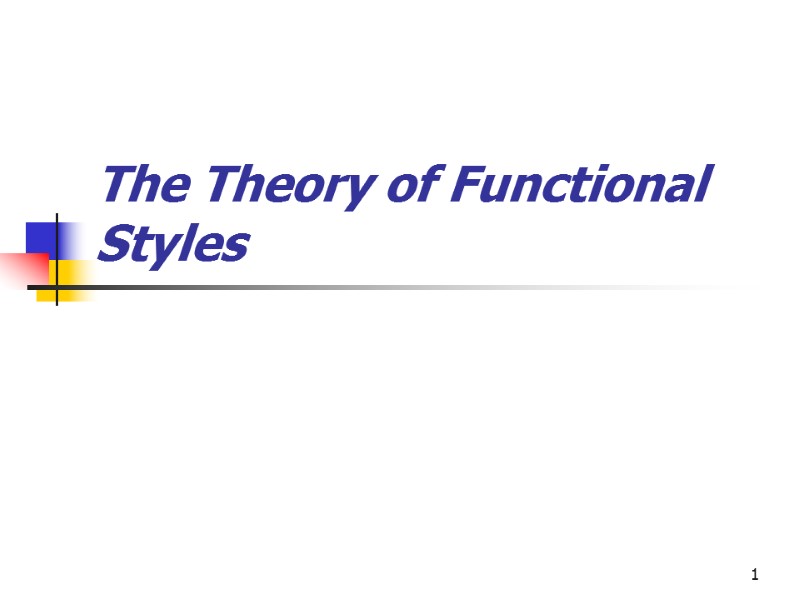
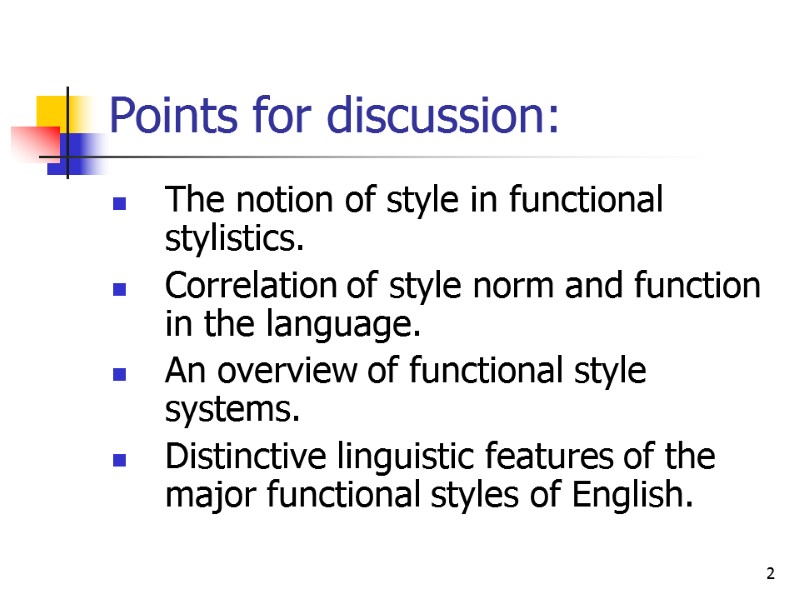
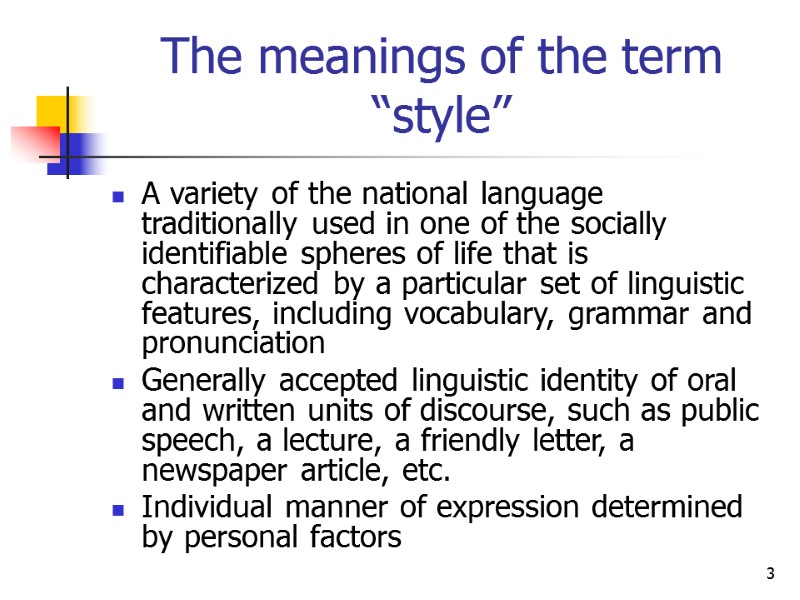
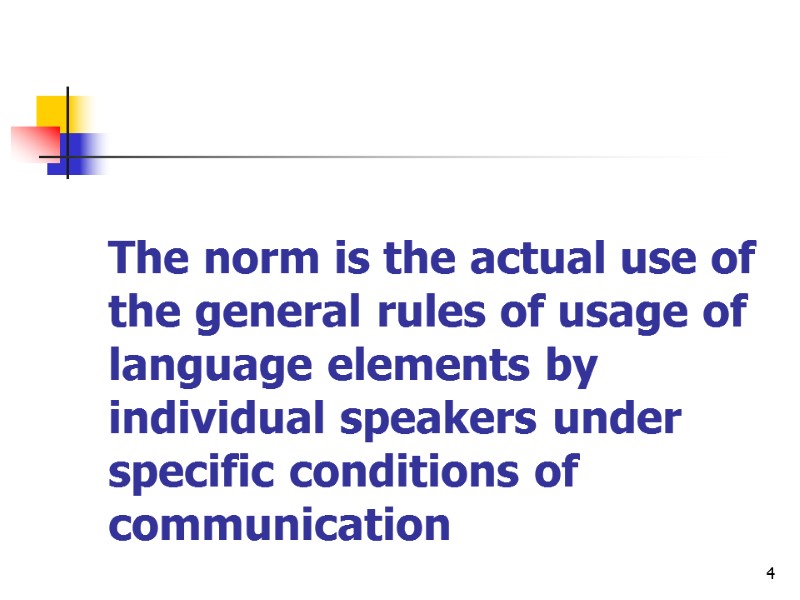
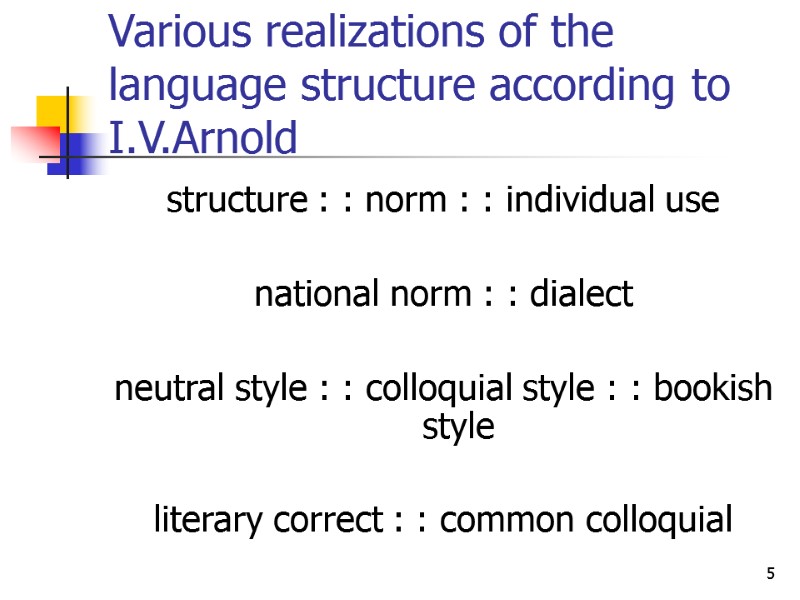
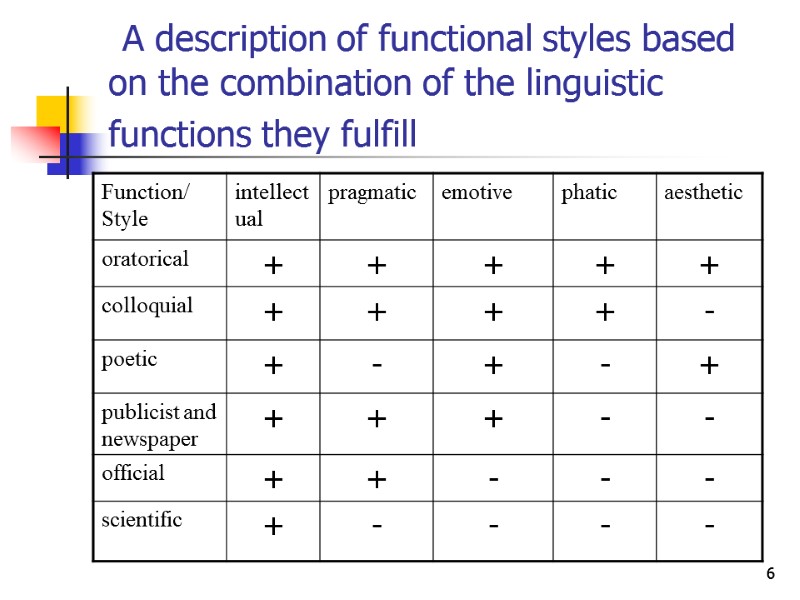
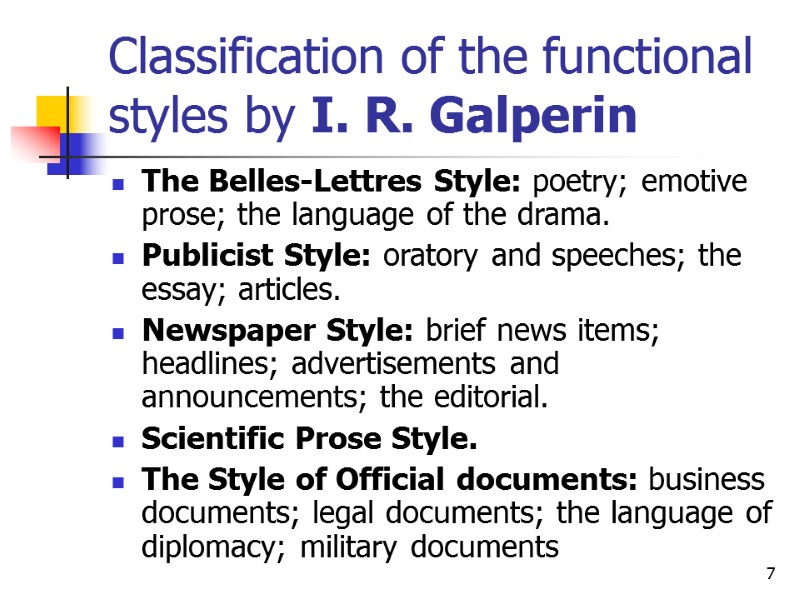
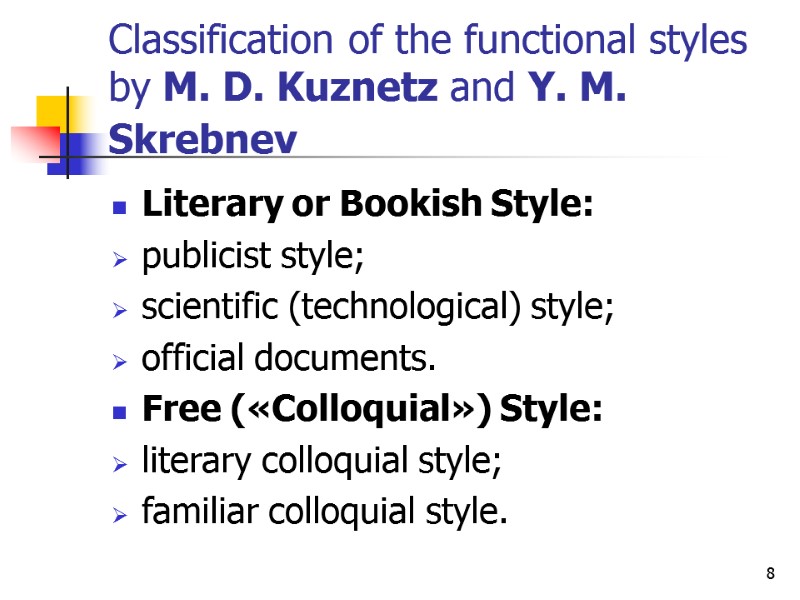
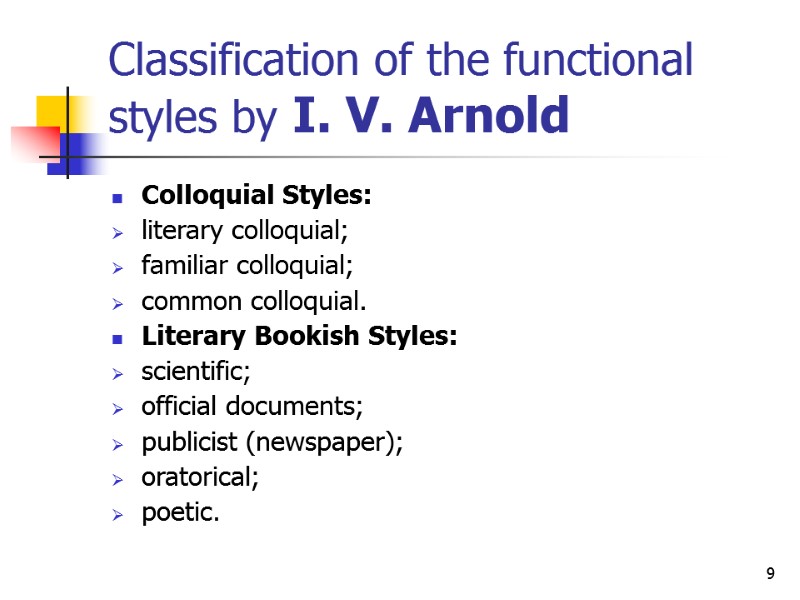
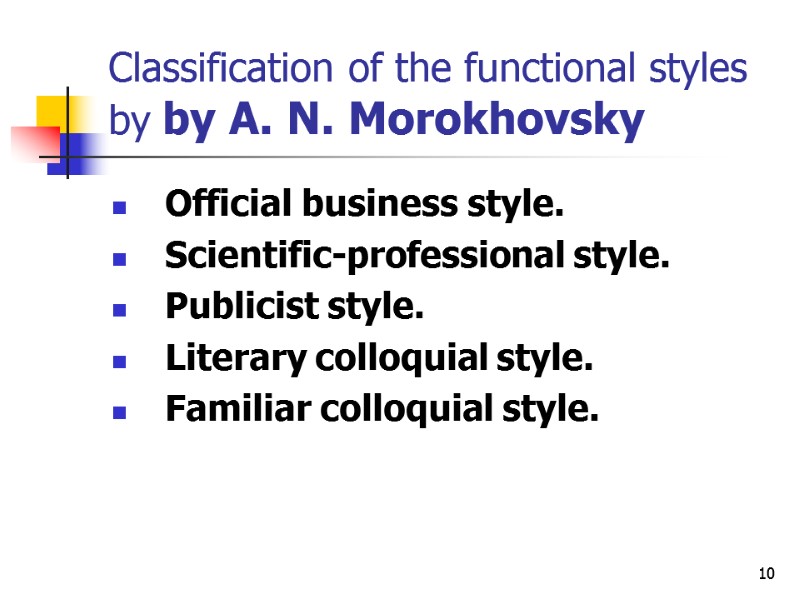
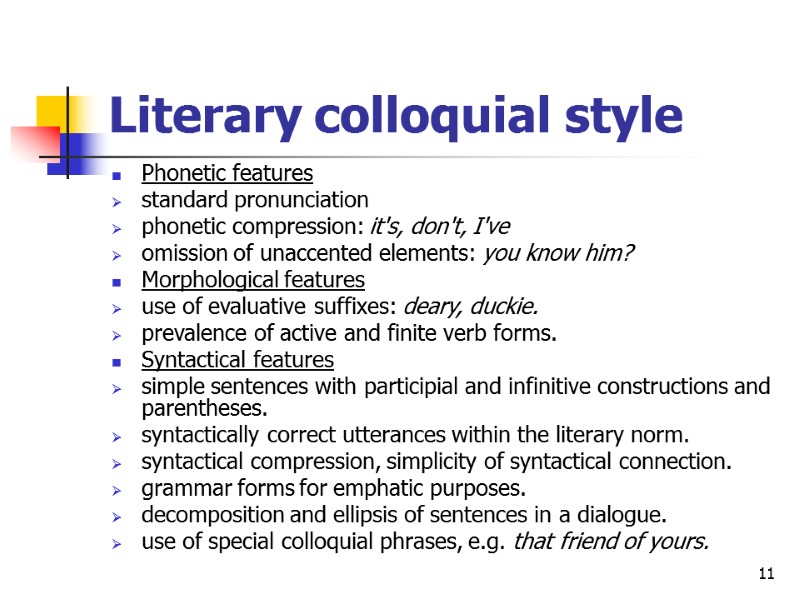

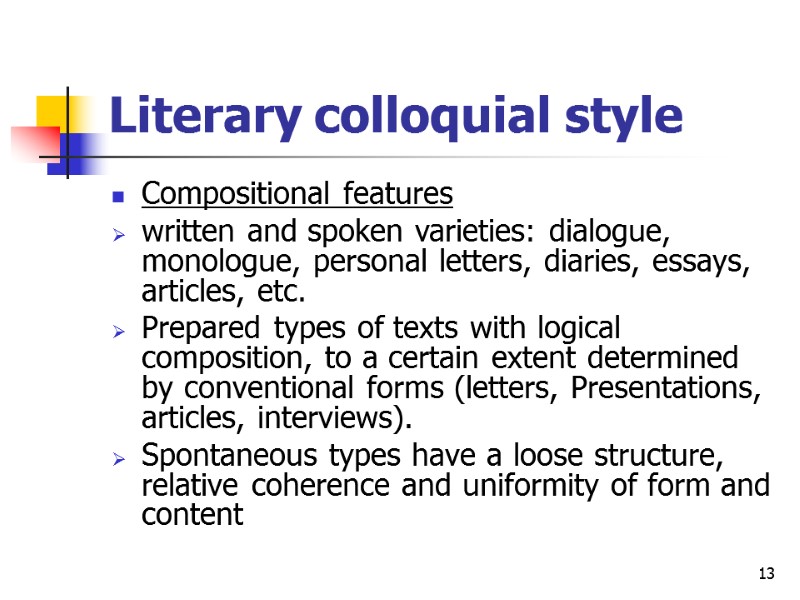
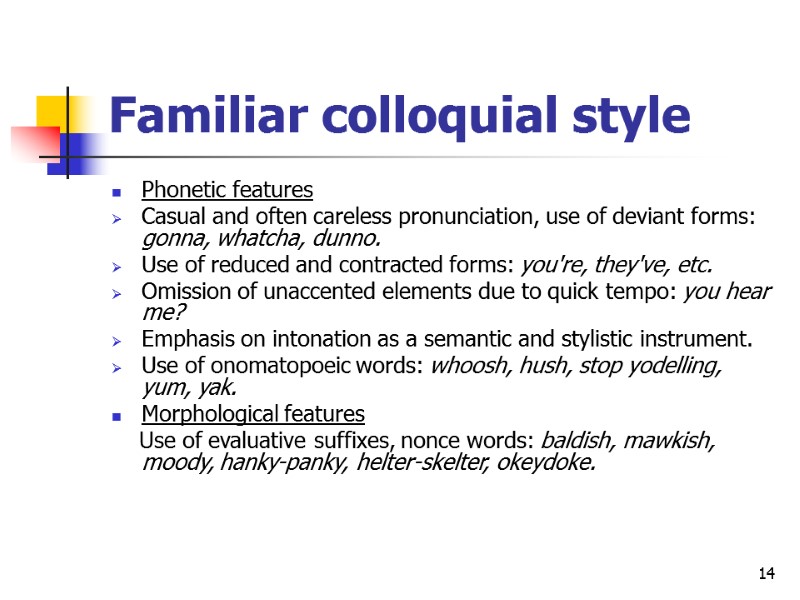
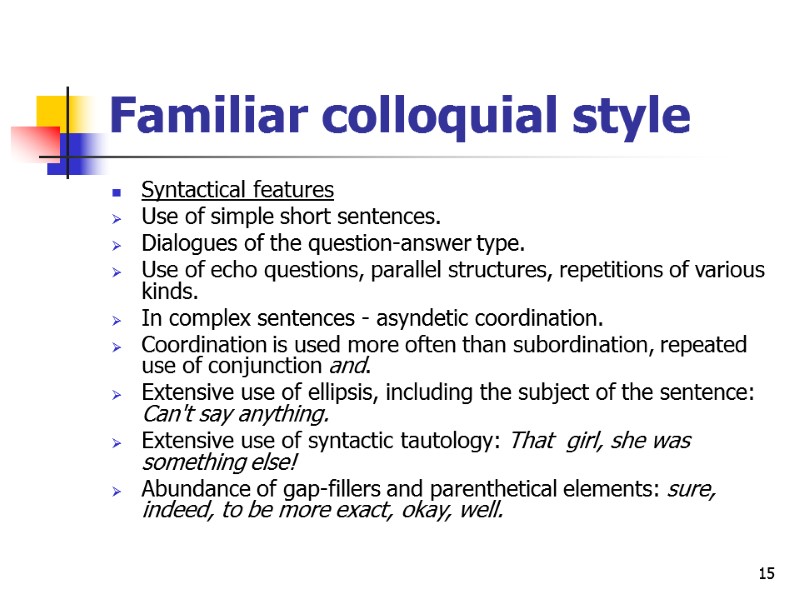
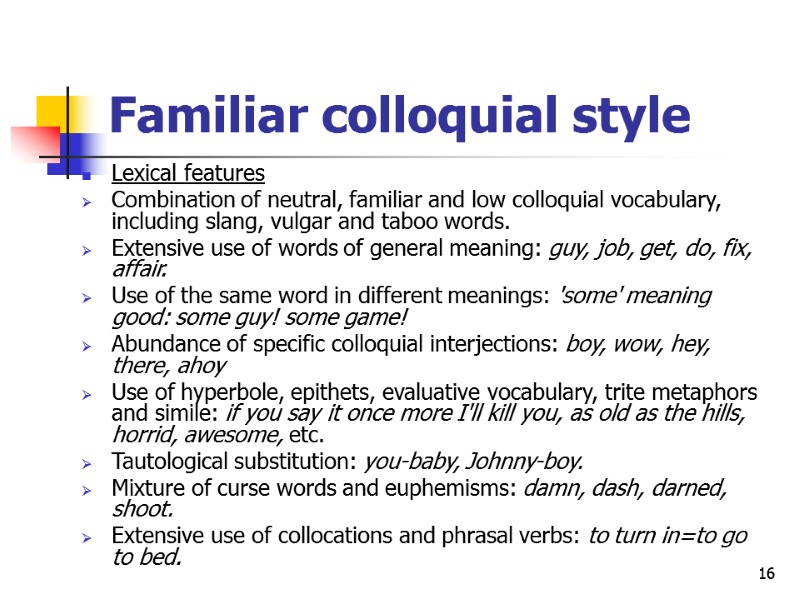
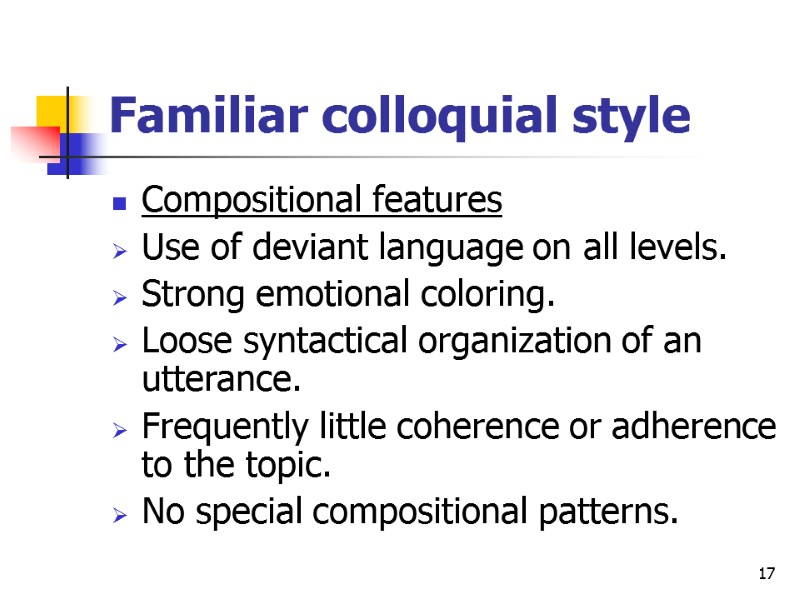
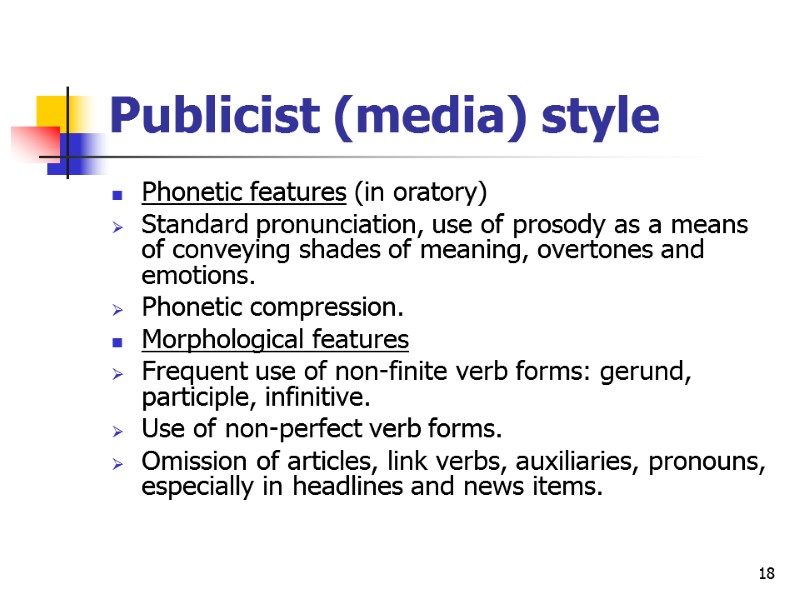
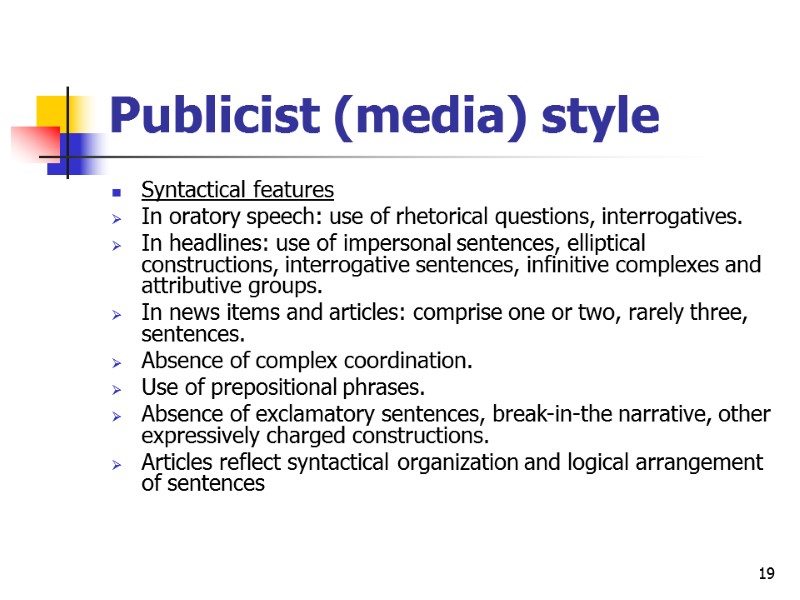
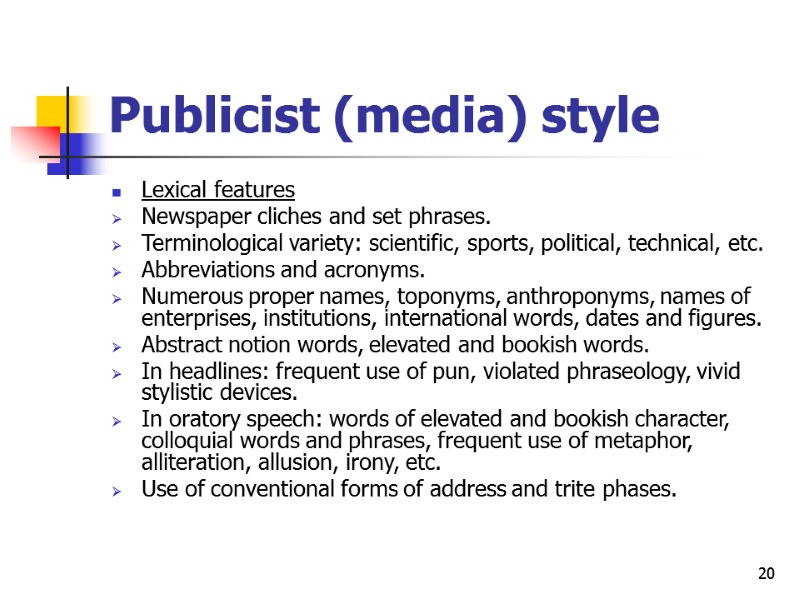
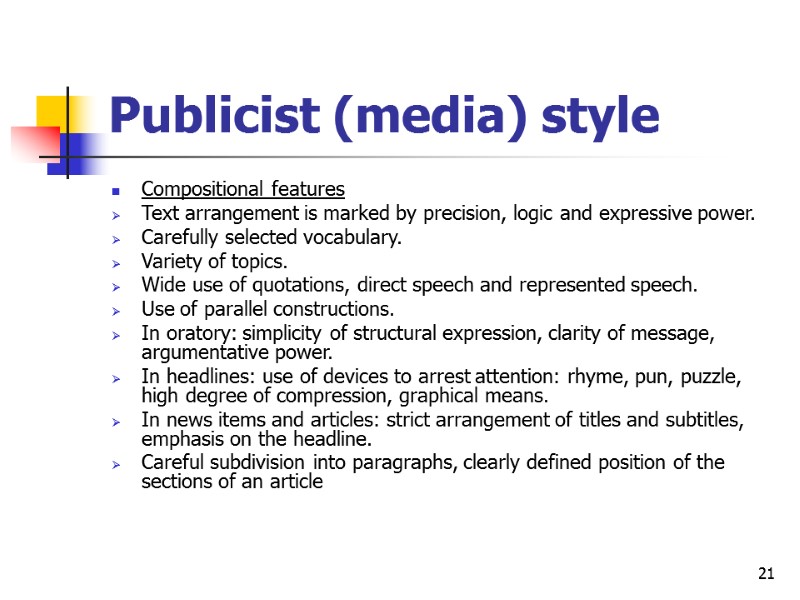
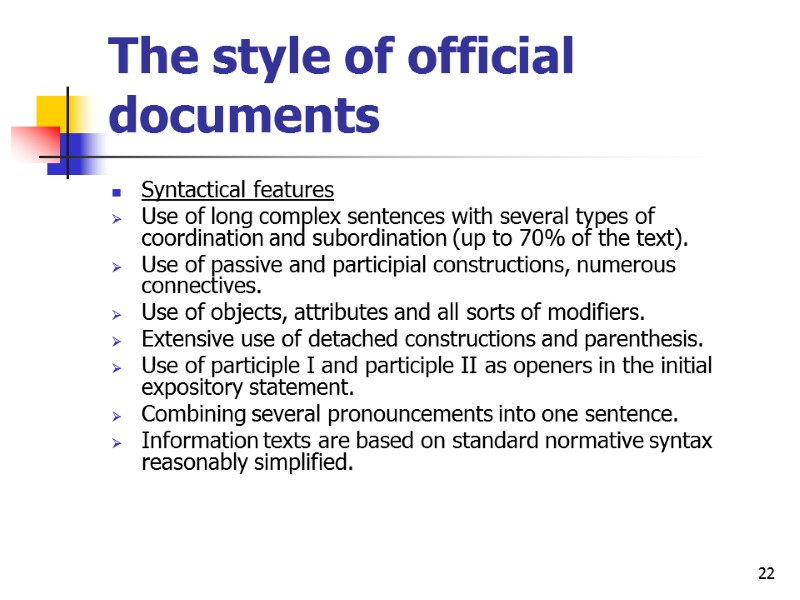
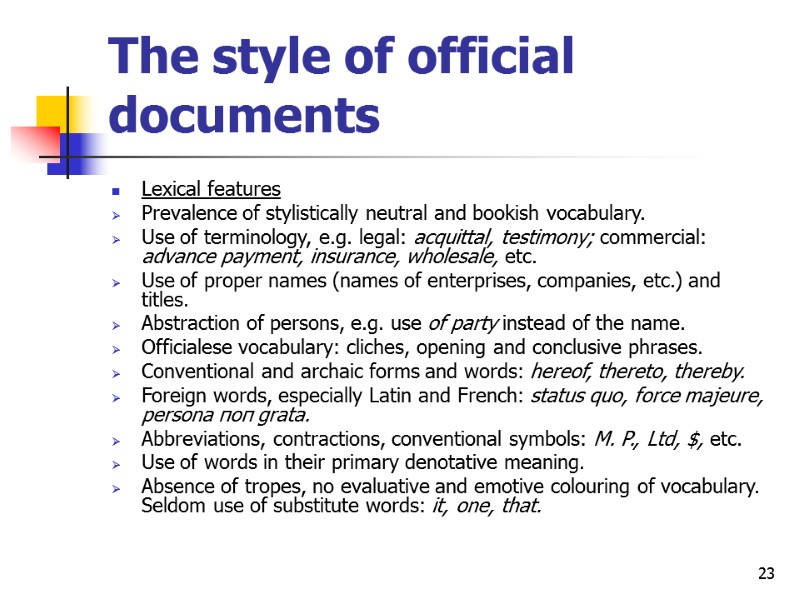
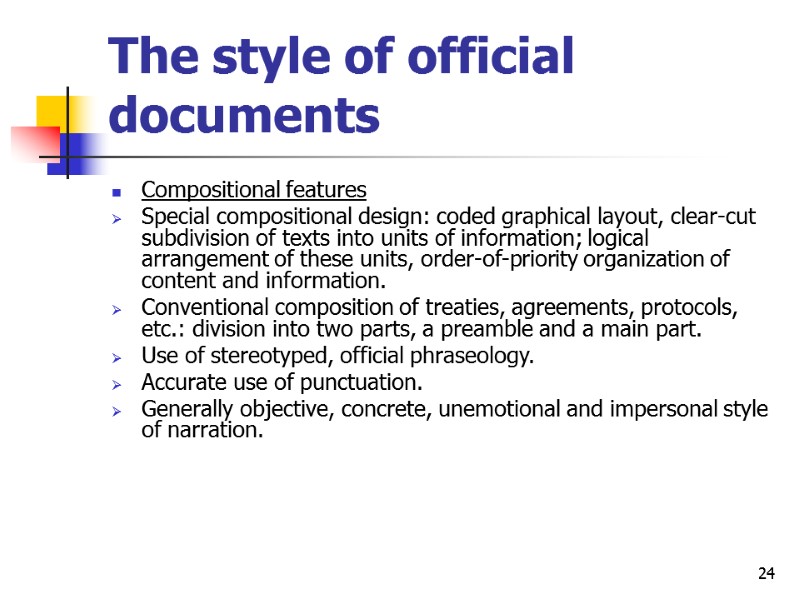
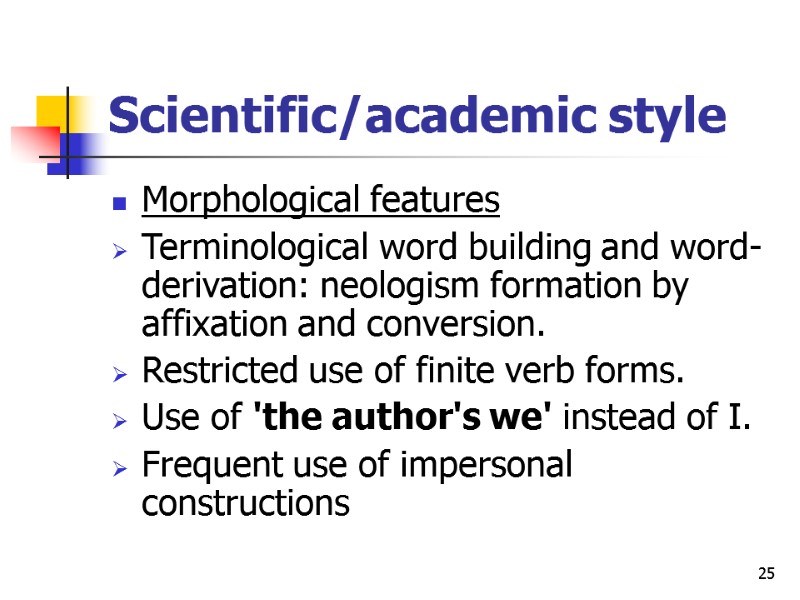
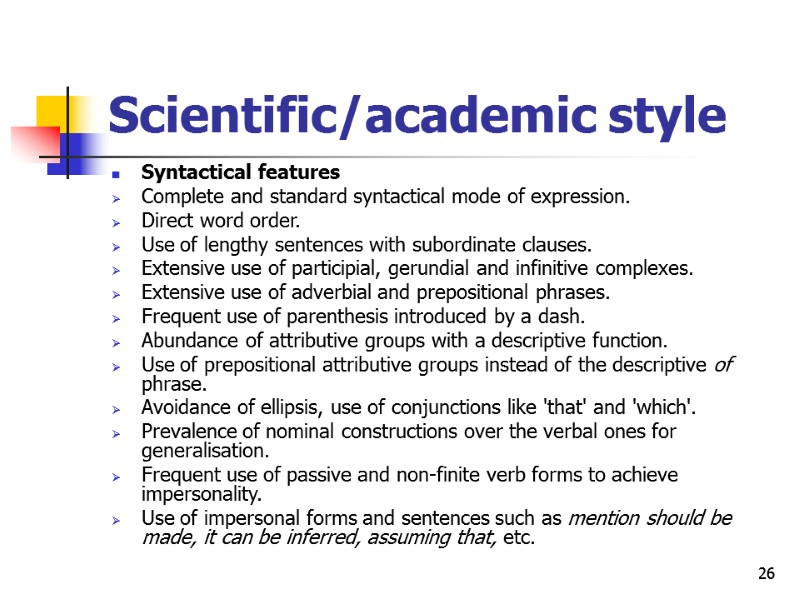
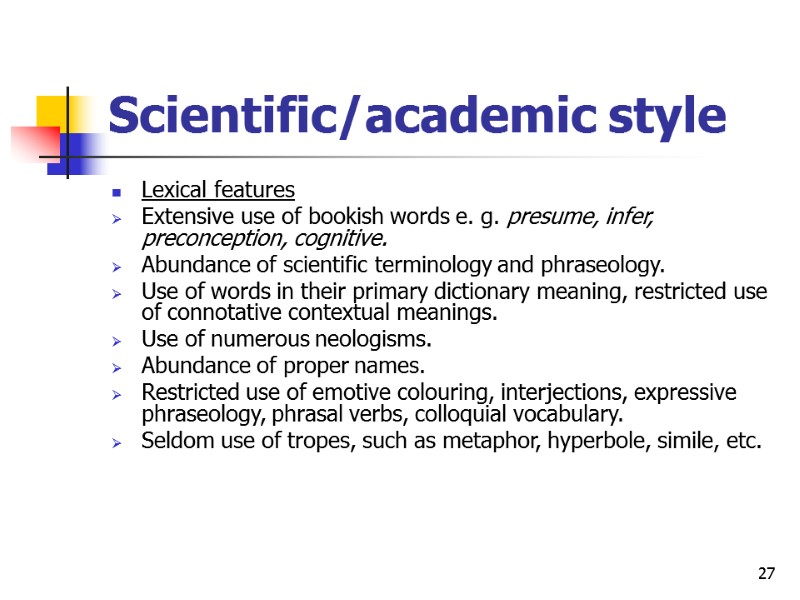
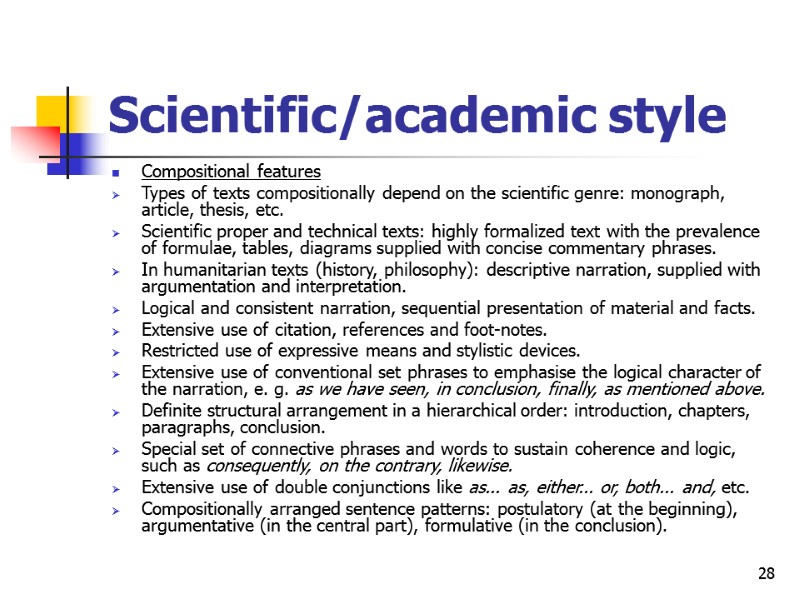
11130-the_theory_of_functional_style.ppt
- Количество слайдов: 28
 1 The Theory of Functional Styles
1 The Theory of Functional Styles
 2 Points for discussion: The notion of style in functional stylistics. Correlation of style norm and function in the language. An overview of functional style systems. Distinctive linguistic features of the major functional styles of English.
2 Points for discussion: The notion of style in functional stylistics. Correlation of style norm and function in the language. An overview of functional style systems. Distinctive linguistic features of the major functional styles of English.
 3 The meanings of the term “style” A variety of the national language traditionally used in one of the socially identifiable spheres of life that is characterized by a particular set of linguistic features, including vocabulary, grammar and pronunciation Generally accepted linguistic identity of oral and written units of discourse, such as public speech, a lecture, a friendly letter, a newspaper article, etc. Individual manner of expression determined by personal factors
3 The meanings of the term “style” A variety of the national language traditionally used in one of the socially identifiable spheres of life that is characterized by a particular set of linguistic features, including vocabulary, grammar and pronunciation Generally accepted linguistic identity of oral and written units of discourse, such as public speech, a lecture, a friendly letter, a newspaper article, etc. Individual manner of expression determined by personal factors
 4 The norm is the actual use of the general rules of usage of language elements by individual speakers under specific conditions of communication
4 The norm is the actual use of the general rules of usage of language elements by individual speakers under specific conditions of communication
 5 Various realizations of the language structure according to I.V.Arnold structure : : norm : : individual use national norm : : dialect neutral style : : colloquial style : : bookish style literary correct : : common colloquial
5 Various realizations of the language structure according to I.V.Arnold structure : : norm : : individual use national norm : : dialect neutral style : : colloquial style : : bookish style literary correct : : common colloquial
 6 A description of functional styles based on the combination of the linguistic functions they fulfill
6 A description of functional styles based on the combination of the linguistic functions they fulfill
 7 Classification of the functional styles by I. R. Galperin The Belles-Lettres Style: poetry; emotive prose; the language of the drama. Publicist Style: oratory and speeches; the essay; articles. Newspaper Style: brief news items; headlines; advertisements and announcements; the editorial. Scientific Prose Style. The Style of Official documents: business documents; legal documents; the language of diplomacy; military documents
7 Classification of the functional styles by I. R. Galperin The Belles-Lettres Style: poetry; emotive prose; the language of the drama. Publicist Style: oratory and speeches; the essay; articles. Newspaper Style: brief news items; headlines; advertisements and announcements; the editorial. Scientific Prose Style. The Style of Official documents: business documents; legal documents; the language of diplomacy; military documents
 8 Classification of the functional styles by M. D. Kuznetz and Y. M. Skrebnev Literary or Bookish Style: publicist style; scientific (technological) style; official documents. Free («Colloquial») Style: literary colloquial style; familiar colloquial style.
8 Classification of the functional styles by M. D. Kuznetz and Y. M. Skrebnev Literary or Bookish Style: publicist style; scientific (technological) style; official documents. Free («Colloquial») Style: literary colloquial style; familiar colloquial style.
 9 Classification of the functional styles by I. V. Arnold Colloquial Styles: literary colloquial; familiar colloquial; common colloquial. Literary Bookish Styles: scientific; official documents; publicist (newspaper); oratorical; poetic.
9 Classification of the functional styles by I. V. Arnold Colloquial Styles: literary colloquial; familiar colloquial; common colloquial. Literary Bookish Styles: scientific; official documents; publicist (newspaper); oratorical; poetic.
 10 Classification of the functional styles by by A. N. Morokhovsky Official business style. Scientific-professional style. Publicist style. Literary colloquial style. Familiar colloquial style.
10 Classification of the functional styles by by A. N. Morokhovsky Official business style. Scientific-professional style. Publicist style. Literary colloquial style. Familiar colloquial style.
 11 Literary colloquial style Phonetic features standard pronunciation phonetic compression: it's, don't, I've omission of unaccented elements: you know him? Morphological features use of evaluative suffixes: deary, duckie. prevalence of active and finite verb forms. Syntactical features simple sentences with participial and infinitive constructions and parentheses. syntactically correct utterances within the literary norm. syntactical compression, simplicity of syntactical connection. grammar forms for emphatic purposes. decomposition and ellipsis of sentences in a dialogue. use of special colloquial phrases, e.g. that friend of yours.
11 Literary colloquial style Phonetic features standard pronunciation phonetic compression: it's, don't, I've omission of unaccented elements: you know him? Morphological features use of evaluative suffixes: deary, duckie. prevalence of active and finite verb forms. Syntactical features simple sentences with participial and infinitive constructions and parentheses. syntactically correct utterances within the literary norm. syntactical compression, simplicity of syntactical connection. grammar forms for emphatic purposes. decomposition and ellipsis of sentences in a dialogue. use of special colloquial phrases, e.g. that friend of yours.
 12 Literary colloquial style Lexical features Wide range of vocabulary : formal and informal, neutral and bookish, terms etc. Basic stock of communicative vocabulary—stylistically neutral. Use of socially accepted contracted forms and abbreviations: fridge, ice, TV, CD Use of conversational formulas: nice to see you, my pleasure, on behalf of, etc. Extensive use of intensifiers and gap-fillers: absolutely, definitely, kind of, etc. Use of interjections and exclamations: Dear me, My God, well, why, now, oh. Extensive use of phrasal verbs: let sb down, put up with, stand sb up. Use of words of indefinite meaning like thing, stuff. Avoidance of slang, vulgarisms, dialect words, jargon. Use of phraseological expressions, idioms and figures of speech.
12 Literary colloquial style Lexical features Wide range of vocabulary : formal and informal, neutral and bookish, terms etc. Basic stock of communicative vocabulary—stylistically neutral. Use of socially accepted contracted forms and abbreviations: fridge, ice, TV, CD Use of conversational formulas: nice to see you, my pleasure, on behalf of, etc. Extensive use of intensifiers and gap-fillers: absolutely, definitely, kind of, etc. Use of interjections and exclamations: Dear me, My God, well, why, now, oh. Extensive use of phrasal verbs: let sb down, put up with, stand sb up. Use of words of indefinite meaning like thing, stuff. Avoidance of slang, vulgarisms, dialect words, jargon. Use of phraseological expressions, idioms and figures of speech.
 13 Literary colloquial style Compositional features written and spoken varieties: dialogue, monologue, personal letters, diaries, essays, articles, etc. Prepared types of texts with logical composition, to a certain extent determined by conventional forms (letters, Presentations, articles, interviews). Spontaneous types have a loose structure, relative coherence and uniformity of form and content
13 Literary colloquial style Compositional features written and spoken varieties: dialogue, monologue, personal letters, diaries, essays, articles, etc. Prepared types of texts with logical composition, to a certain extent determined by conventional forms (letters, Presentations, articles, interviews). Spontaneous types have a loose structure, relative coherence and uniformity of form and content
 14 Familiar colloquial style Phonetic features Casual and often careless pronunciation, use of deviant forms: gonna, whatcha, dunno. Use of reduced and contracted forms: you're, they've, etc. Omission of unaccented elements due to quick tempo: you hear me? Emphasis on intonation as a semantic and stylistic instrument. Use of onomatopoeic words: whoosh, hush, stop yodelling, yum, yak. Morphological features Use of evaluative suffixes, nonce words: baldish, mawkish, moody, hanky-panky, helter-skelter, okeydoke.
14 Familiar colloquial style Phonetic features Casual and often careless pronunciation, use of deviant forms: gonna, whatcha, dunno. Use of reduced and contracted forms: you're, they've, etc. Omission of unaccented elements due to quick tempo: you hear me? Emphasis on intonation as a semantic and stylistic instrument. Use of onomatopoeic words: whoosh, hush, stop yodelling, yum, yak. Morphological features Use of evaluative suffixes, nonce words: baldish, mawkish, moody, hanky-panky, helter-skelter, okeydoke.
 15 Familiar colloquial style Syntactical features Use of simple short sentences. Dialogues of the question-answer type. Use of echo questions, parallel structures, repetitions of various kinds. In complex sentences - asyndetic coordination. Coordination is used more often than subordination, repeated use of conjunction and. Extensive use of ellipsis, including the subject of the sentence: Can't say anything. Extensive use of syntactic tautology: That girl, she was something else! Abundance of gap-fillers and parenthetical elements: sure, indeed, to be more exact, okay, well.
15 Familiar colloquial style Syntactical features Use of simple short sentences. Dialogues of the question-answer type. Use of echo questions, parallel structures, repetitions of various kinds. In complex sentences - asyndetic coordination. Coordination is used more often than subordination, repeated use of conjunction and. Extensive use of ellipsis, including the subject of the sentence: Can't say anything. Extensive use of syntactic tautology: That girl, she was something else! Abundance of gap-fillers and parenthetical elements: sure, indeed, to be more exact, okay, well.
 16 Familiar colloquial style Lexical features Combination of neutral, familiar and low colloquial vocabulary, including slang, vulgar and taboo words. Extensive use of words of general meaning: guy, job, get, do, fix, affair. Use of the same word in different meanings: 'some' meaning good: some guy! some game! Abundance of specific colloquial interjections: boy, wow, hey, there, ahoy Use of hyperbole, epithets, evaluative vocabulary, trite metaphors and simile: if you say it once more I'll kill you, as old as the hills, horrid, awesome, etc. Tautological substitution: you-baby, Johnny-boy. Mixture of curse words and euphemisms: damn, dash, darned, shoot. Extensive use of collocations and phrasal verbs: to turn in=to go to bed.
16 Familiar colloquial style Lexical features Combination of neutral, familiar and low colloquial vocabulary, including slang, vulgar and taboo words. Extensive use of words of general meaning: guy, job, get, do, fix, affair. Use of the same word in different meanings: 'some' meaning good: some guy! some game! Abundance of specific colloquial interjections: boy, wow, hey, there, ahoy Use of hyperbole, epithets, evaluative vocabulary, trite metaphors and simile: if you say it once more I'll kill you, as old as the hills, horrid, awesome, etc. Tautological substitution: you-baby, Johnny-boy. Mixture of curse words and euphemisms: damn, dash, darned, shoot. Extensive use of collocations and phrasal verbs: to turn in=to go to bed.
 17 Familiar colloquial style Compositional features Use of deviant language on all levels. Strong emotional coloring. Loose syntactical organization of an utterance. Frequently little coherence or adherence to the topic. No special compositional patterns.
17 Familiar colloquial style Compositional features Use of deviant language on all levels. Strong emotional coloring. Loose syntactical organization of an utterance. Frequently little coherence or adherence to the topic. No special compositional patterns.
 18 Publicist (media) style Phonetic features (in oratory) Standard pronunciation, use of prosody as a means of conveying shades of meaning, overtones and emotions. Phonetic compression. Morphological features Frequent use of non-finite verb forms: gerund, participle, infinitive. Use of non-perfect verb forms. Omission of articles, link verbs, auxiliaries, pronouns, especially in headlines and news items.
18 Publicist (media) style Phonetic features (in oratory) Standard pronunciation, use of prosody as a means of conveying shades of meaning, overtones and emotions. Phonetic compression. Morphological features Frequent use of non-finite verb forms: gerund, participle, infinitive. Use of non-perfect verb forms. Omission of articles, link verbs, auxiliaries, pronouns, especially in headlines and news items.
 19 Publicist (media) style Syntactical features In oratory speech: use of rhetorical questions, interrogatives. In headlines: use of impersonal sentences, elliptical constructions, interrogative sentences, infinitive complexes and attributive groups. In news items and articles: comprise one or two, rarely three, sentences. Absence of complex coordination. Use of prepositional phrases. Absence of exclamatory sentences, break-in-the narrative, other expressively charged constructions. Articles reflect syntactical organization and logical arrangement of sentences
19 Publicist (media) style Syntactical features In oratory speech: use of rhetorical questions, interrogatives. In headlines: use of impersonal sentences, elliptical constructions, interrogative sentences, infinitive complexes and attributive groups. In news items and articles: comprise one or two, rarely three, sentences. Absence of complex coordination. Use of prepositional phrases. Absence of exclamatory sentences, break-in-the narrative, other expressively charged constructions. Articles reflect syntactical organization and logical arrangement of sentences
 20 Publicist (media) style Lexical features Newspaper cliches and set phrases. Terminological variety: scientific, sports, political, technical, etc. Abbreviations and acronyms. Numerous proper names, toponyms, anthroponyms, names of enterprises, institutions, international words, dates and figures. Abstract notion words, elevated and bookish words. In headlines: frequent use of pun, violated phraseology, vivid stylistic devices. In oratory speech: words of elevated and bookish character, colloquial words and phrases, frequent use of metaphor, alliteration, allusion, irony, etc. Use of conventional forms of address and trite phases.
20 Publicist (media) style Lexical features Newspaper cliches and set phrases. Terminological variety: scientific, sports, political, technical, etc. Abbreviations and acronyms. Numerous proper names, toponyms, anthroponyms, names of enterprises, institutions, international words, dates and figures. Abstract notion words, elevated and bookish words. In headlines: frequent use of pun, violated phraseology, vivid stylistic devices. In oratory speech: words of elevated and bookish character, colloquial words and phrases, frequent use of metaphor, alliteration, allusion, irony, etc. Use of conventional forms of address and trite phases.
 21 Publicist (media) style Compositional features Text arrangement is marked by precision, logic and expressive power. Carefully selected vocabulary. Variety of topics. Wide use of quotations, direct speech and represented speech. Use of parallel constructions. In oratory: simplicity of structural expression, clarity of message, argumentative power. In headlines: use of devices to arrest attention: rhyme, pun, puzzle, high degree of compression, graphical means. In news items and articles: strict arrangement of titles and subtitles, emphasis on the headline. Careful subdivision into paragraphs, clearly defined position of the sections of an article
21 Publicist (media) style Compositional features Text arrangement is marked by precision, logic and expressive power. Carefully selected vocabulary. Variety of topics. Wide use of quotations, direct speech and represented speech. Use of parallel constructions. In oratory: simplicity of structural expression, clarity of message, argumentative power. In headlines: use of devices to arrest attention: rhyme, pun, puzzle, high degree of compression, graphical means. In news items and articles: strict arrangement of titles and subtitles, emphasis on the headline. Careful subdivision into paragraphs, clearly defined position of the sections of an article
 22 The style of official documents Syntactical features Use of long complex sentences with several types of coordination and subordination (up to 70% of the text). Use of passive and participial constructions, numerous connectives. Use of objects, attributes and all sorts of modifiers. Extensive use of detached constructions and parenthesis. Use of participle I and participle II as openers in the initial expository statement. Combining several pronouncements into one sentence. Information texts are based on standard normative syntax reasonably simplified.
22 The style of official documents Syntactical features Use of long complex sentences with several types of coordination and subordination (up to 70% of the text). Use of passive and participial constructions, numerous connectives. Use of objects, attributes and all sorts of modifiers. Extensive use of detached constructions and parenthesis. Use of participle I and participle II as openers in the initial expository statement. Combining several pronouncements into one sentence. Information texts are based on standard normative syntax reasonably simplified.
 23 The style of official documents Lexical features Prevalence of stylistically neutral and bookish vocabulary. Use of terminology, e.g. legal: acquittal, testimony; commercial: advance payment, insurance, wholesale, etc. Use of proper names (names of enterprises, companies, etc.) and titles. Abstraction of persons, e.g. use of party instead of the name. Officialese vocabulary: cliches, opening and conclusive phrases. Conventional and archaic forms and words: hereof, thereto, thereby. Foreign words, especially Latin and French: status quo, force majeure, persona поп grata. Abbreviations, contractions, conventional symbols: M. P., Ltd, $, etc. Use of words in their primary denotative meaning. Absence of tropes, no evaluative and emotive colouring of vocabulary. Seldom use of substitute words: it, one, that.
23 The style of official documents Lexical features Prevalence of stylistically neutral and bookish vocabulary. Use of terminology, e.g. legal: acquittal, testimony; commercial: advance payment, insurance, wholesale, etc. Use of proper names (names of enterprises, companies, etc.) and titles. Abstraction of persons, e.g. use of party instead of the name. Officialese vocabulary: cliches, opening and conclusive phrases. Conventional and archaic forms and words: hereof, thereto, thereby. Foreign words, especially Latin and French: status quo, force majeure, persona поп grata. Abbreviations, contractions, conventional symbols: M. P., Ltd, $, etc. Use of words in their primary denotative meaning. Absence of tropes, no evaluative and emotive colouring of vocabulary. Seldom use of substitute words: it, one, that.
 24 The style of official documents Compositional features Special compositional design: coded graphical layout, clear-cut subdivision of texts into units of information; logical arrangement of these units, order-of-priority organization of content and information. Conventional composition of treaties, agreements, protocols, etc.: division into two parts, a preamble and a main part. Use of stereotyped, official phraseology. Accurate use of punctuation. Generally objective, concrete, unemotional and impersonal style of narration.
24 The style of official documents Compositional features Special compositional design: coded graphical layout, clear-cut subdivision of texts into units of information; logical arrangement of these units, order-of-priority organization of content and information. Conventional composition of treaties, agreements, protocols, etc.: division into two parts, a preamble and a main part. Use of stereotyped, official phraseology. Accurate use of punctuation. Generally objective, concrete, unemotional and impersonal style of narration.
 25 Scientific/academic style Morphological features Terminological word building and word-derivation: neologism formation by affixation and conversion. Restricted use of finite verb forms. Use of 'the author's we' instead of I. Frequent use of impersonal constructions
25 Scientific/academic style Morphological features Terminological word building and word-derivation: neologism formation by affixation and conversion. Restricted use of finite verb forms. Use of 'the author's we' instead of I. Frequent use of impersonal constructions
 26 Scientific/academic style Syntactical features Complete and standard syntactical mode of expression. Direct word order. Use of lengthy sentences with subordinate clauses. Extensive use of participial, gerundial and infinitive complexes. Extensive use of adverbial and prepositional phrases. Frequent use of parenthesis introduced by a dash. Abundance of attributive groups with a descriptive function. Use of prepositional attributive groups instead of the descriptive of phrase. Avoidance of ellipsis, use of conjunctions like 'that' and 'which'. Prevalence of nominal constructions over the verbal ones for generalisation. Frequent use of passive and non-finite verb forms to achieve impersonality. Use of impersonal forms and sentences such as mention should be made, it can be inferred, assuming that, etc.
26 Scientific/academic style Syntactical features Complete and standard syntactical mode of expression. Direct word order. Use of lengthy sentences with subordinate clauses. Extensive use of participial, gerundial and infinitive complexes. Extensive use of adverbial and prepositional phrases. Frequent use of parenthesis introduced by a dash. Abundance of attributive groups with a descriptive function. Use of prepositional attributive groups instead of the descriptive of phrase. Avoidance of ellipsis, use of conjunctions like 'that' and 'which'. Prevalence of nominal constructions over the verbal ones for generalisation. Frequent use of passive and non-finite verb forms to achieve impersonality. Use of impersonal forms and sentences such as mention should be made, it can be inferred, assuming that, etc.
 27 Scientific/academic style Lexical features Extensive use of bookish words e. g. presume, infer, preconception, cognitive. Abundance of scientific terminology and phraseology. Use of words in their primary dictionary meaning, restricted use of connotative contextual meanings. Use of numerous neologisms. Abundance of proper names. Restricted use of emotive colouring, interjections, expressive phraseology, phrasal verbs, colloquial vocabulary. Seldom use of tropes, such as metaphor, hyperbole, simile, etc.
27 Scientific/academic style Lexical features Extensive use of bookish words e. g. presume, infer, preconception, cognitive. Abundance of scientific terminology and phraseology. Use of words in their primary dictionary meaning, restricted use of connotative contextual meanings. Use of numerous neologisms. Abundance of proper names. Restricted use of emotive colouring, interjections, expressive phraseology, phrasal verbs, colloquial vocabulary. Seldom use of tropes, such as metaphor, hyperbole, simile, etc.
 28 Scientific/academic style Compositional features Types of texts compositionally depend on the scientific genre: monograph, article, thesis, etc. Scientific proper and technical texts: highly formalized text with the prevalence of formulae, tables, diagrams supplied with concise commentary phrases. In humanitarian texts (history, philosophy): descriptive narration, supplied with argumentation and interpretation. Logical and consistent narration, sequential presentation of material and facts. Extensive use of citation, references and foot-notes. Restricted use of expressive means and stylistic devices. Extensive use of conventional set phrases to emphasise the logical character of the narration, e. g. as we have seen, in conclusion, finally, as mentioned above. Definite structural arrangement in a hierarchical order: introduction, chapters, paragraphs, conclusion. Special set of connective phrases and words to sustain coherence and logic, such as consequently, on the contrary, likewise. Extensive use of double conjunctions like as... as, either... or, both... and, etc. Compositionally arranged sentence patterns: postulatory (at the beginning), argumentative (in the central part), formulative (in the conclusion).
28 Scientific/academic style Compositional features Types of texts compositionally depend on the scientific genre: monograph, article, thesis, etc. Scientific proper and technical texts: highly formalized text with the prevalence of formulae, tables, diagrams supplied with concise commentary phrases. In humanitarian texts (history, philosophy): descriptive narration, supplied with argumentation and interpretation. Logical and consistent narration, sequential presentation of material and facts. Extensive use of citation, references and foot-notes. Restricted use of expressive means and stylistic devices. Extensive use of conventional set phrases to emphasise the logical character of the narration, e. g. as we have seen, in conclusion, finally, as mentioned above. Definite structural arrangement in a hierarchical order: introduction, chapters, paragraphs, conclusion. Special set of connective phrases and words to sustain coherence and logic, such as consequently, on the contrary, likewise. Extensive use of double conjunctions like as... as, either... or, both... and, etc. Compositionally arranged sentence patterns: postulatory (at the beginning), argumentative (in the central part), formulative (in the conclusion).
